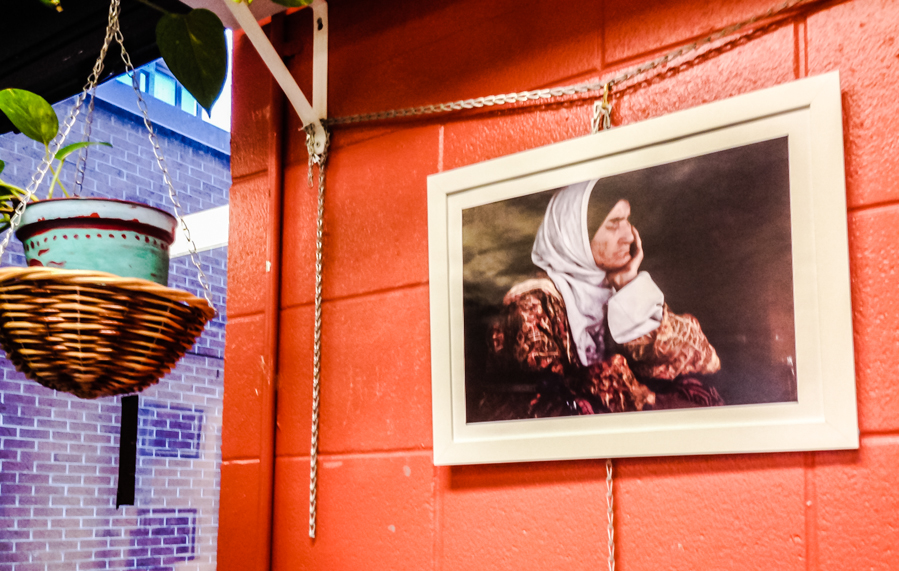They say one person’s misfortune is a tragedy but the misfortune of millions is a statistic. The uprooting of millions in Syria since the popular uprisings in 2011 is no exception to this trope. The mainstream media frequently throws unfathomable statistics at viewers regarding refugees and the internally displaced, reducing people to numbers. And when images accompany these statistics, they often exclusively portray suffering, injuries, and death, depicting the subjects as victims.
Tadamon!, a Montreal-based collective working for solidarity with social justice struggles in the Middle East, provides a counter-narrative to this popular sensationalization of the Syrian displacement crisis with its current exhibit “Uprising and Uprooted: refugees in the Syrian struggle in photo and image.” “Uprising and Uprooted,” on display at Café Aquin, shares stories from the ongoing crisis without presenting it as synonymous with the defeat of the uprising. The exhibit features photos by Rami al-Sayyed, Niraz Saeid, Umama Hamido, Montreal-based artist Jessica Attar Adam, and the late Toronto-based photojournalist Ali Mustafa, who was killed in an aerial bombing in Syria this past March.
In contrast to the images of Syria in mainstream media, this exhibit is firmly rooted in the everyday experiences of the displaced. In fact, the photos scattered on the walls of Café Aquin are not even immediately recognizable as a narrative of the Syrian refugee crisis. In one corner of the café, a young boy smiles a contagious smile in a black and white photo. He is standing and beaming, his legs straddling a bike, his back turned to a seemingly deserted street. Above this photo hangs another untitled and uncredited image. It’s a portrait of an elderly woman’s profile, set against a black background. The void-like backdrop draws all focus to the woman’s face – wrinkled forehead, eyes shut, lips pursed. Her controlled expression hints at exhaustion and the weight of heavy thoughts. Taken together, the boy and the elderly woman express resilience. It is their faces, and not a backdrop of rubble and destruction, that dominate the photographs. Even with their straight posture, the camera captures a dignified defiance in their stance.
One of the organizers of the exhibit, Oula Hajjar, explained to The Daily that demonstrating this defiance was a large part of the exhibit’s purpose. Hajjar described the exhibit as “an act of solidarity” that sought to “show the strength of [the] people behind the revolution.” She explained that the collective “really made an effort to choose photos that have hope [and] joy, not just disaster. We didn’t want to see dead people; that’s not the point, to count how many people are dead.”
In addition to these portraits of strength, the exhibit heavily features photos of children, depicting the “hope [and] joy” described by Hajjar. Many of the images capture the daily life of kids in refugee camps, highlighting the different generations behind the revolution. One photo by Ali Mustafa shows a young girl giving the ‘v for victory’ sign with her fingers, standing in front of a tent in the Atmeh refugee camp in Idlib. The tent in the background is blurred and much of the girl’s face is shielded by her hands, so that the viewer is left with only her proud gesture in focus. Framed by the white tent, the picture exudes a sense of peace and quiet. The brief description of the photo alerts viewers that “at least half of the nearly 30,000 inhabitants of the [refugee camp] are children under [the age of] 15.” Another photograph by Mustafa shows a young Syrian girl rolling a tire down a hill in Atmeh. The light in the photo is bright, casting out a feeling of hopefulness. Its story is playful.
In contrast, a black-and-white photo by Jessica Attar, also taken in Atmeh, depicts a child peeking out at the camera from behind a tent, leaving a distinctly ominous impression. The photo is called Peur de l’inconnu (fear of the unknown); the image draws attention not only to the child’s fear but to the courage of daring to look out. The viewer, like the child, is confronted with this great unknown, and, like the child, fears what may be lurking on the other side of the tent.
True to its vision, “Uprising and Uprooted” is an act of solidarity. Capturing moments of resilience in an everyday struggle for survival, the photos in the exhibit do not come off as just an awareness-raising campaign. Instead, the exhibit is a cohesive and captivating representation of the everyday experiences of displaced individuals. In their raw honesty, these images subvert the victim narrative, telling instead a story of perseverance, strength, and the light amidst the dark.
“Uprising and Uprooted” closes on Friday, November 7 at 7 p.m. with a screening of the film “Return to Homs,” at Café Aquin, presented by Tadamon! and Cinema Politica Concordia.

